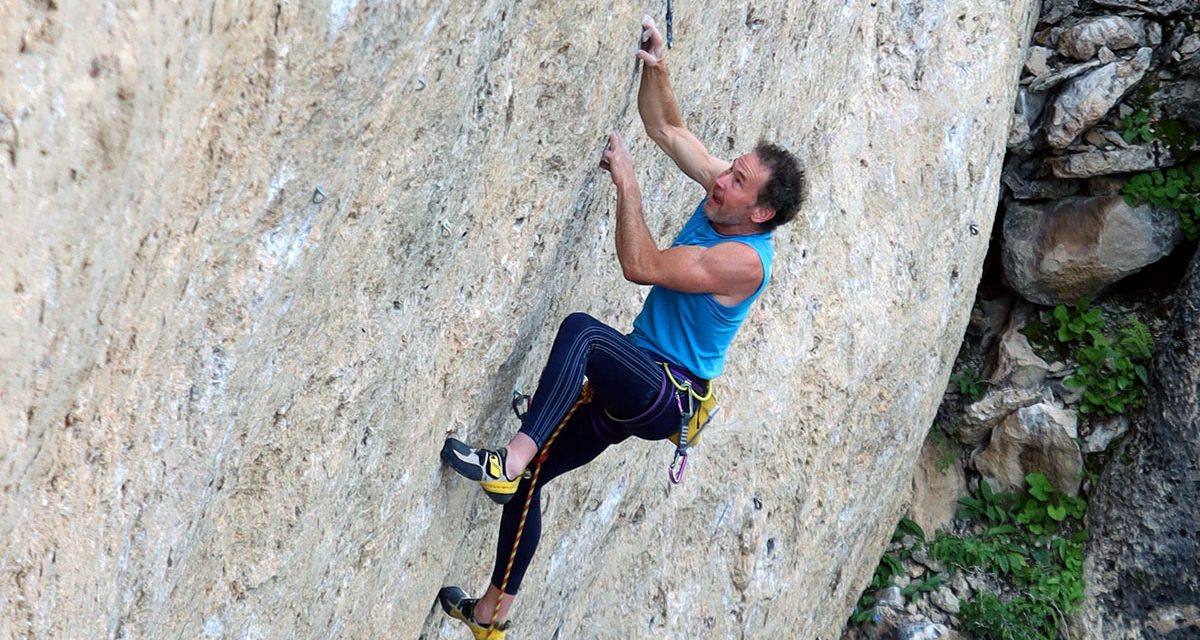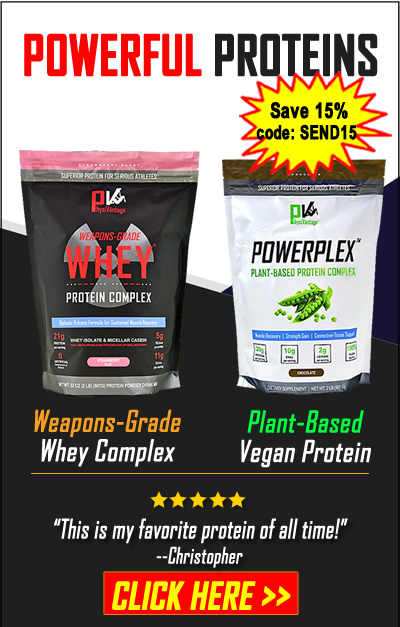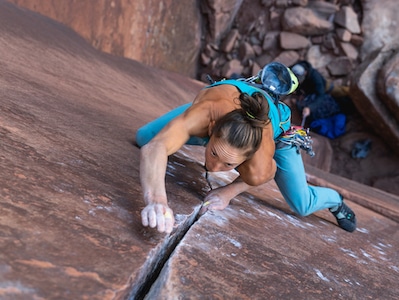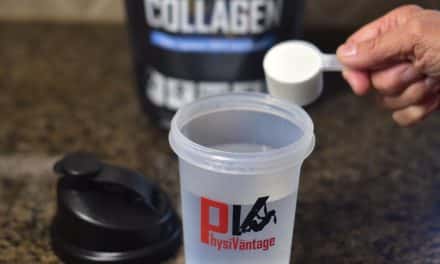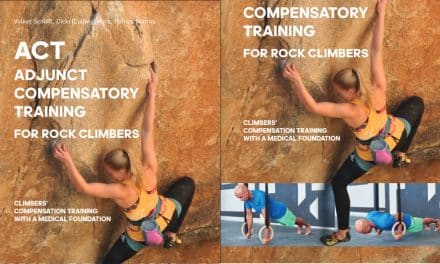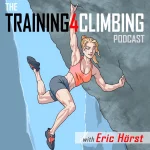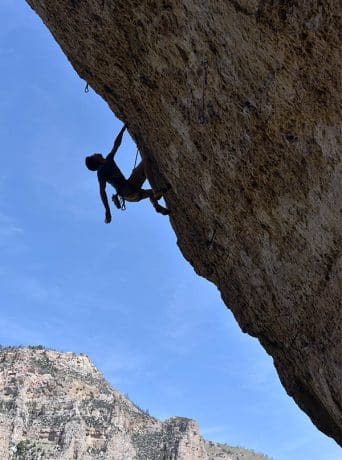
(This article was originally published in July of 2019, but your protein needs as a climber are still as important as ever!)
Amino acids derived from the foods you consume are the building blocks of muscles, tendons and ligaments, vital organs, and skin. Strenuous exercise increases protein turnover, so dietary protein requirements are higher for athletes.
How Much Protein Do You Need?
While the daily protein requirement for a sedentary person is pretty modest (0.8 grams of protein per kilogram of body weight), the American College of Sports Medicine recommends upping that to 1.2-2.0 grams of protein per kilogram of body weight for athletes. For the average climber of slight build and moderate training volume, I recommend starting near the low end of this range (1.2-1.6 grams/kg/day). That’s approximately 70 grams of protein per day for a 115 lb female and 100 grams per day for a 165 lb male. You can easily consume this amount with a few servings of animal-based protein (skim milk, eggs, chicken, fish, lean red meat, or protein powder) along with several servings of nuts, seeds, and legumes.
But the story doesn’t end there, because not all proteins are created equal. Getting enough high-quality protein—with the specific amino acids needed to support muscle and collagen protein synthesis—takes a bit more effort.
Amino Acids as Building Blocks
The protein in the food you eat gets broken down into 20 different amino acids. These are then used to synthesize structural proteins throughout your body. Think of amino acids as the building blocks of your organs, muscles, tendons, ligaments, cartilage, skin, and other tissues. They also provide energy, support digestion, and are involved in numerous enzymatic reactions including vital hormonal and neurotransmitter signaling.
Different amino acids play different roles in the body, however, so the unique amino acid profile (a.k.a. the relative amount of each amino acid) of different foods matters. For example, the amino acid profile of red meat differs from that of eggs or milk. The amino acid profile of vegetables, beans, soy, and other common vegan protein sources is drastically different from that of animal products.
Each amino acid (or combination of amino acids) is linked to different functions in your body. With that in mind, individual differences like lifestyle, stress, exercise, etc. can translate to unique amino acids requirements. Leucine, for instance, is important for signaling muscle protein synthesis. Athletes undergoing hard training will likely benefit from high amounts of leucine (and other BCAAs). Tryptophan is needed to create serotonin, which impacts individuals under mental and emotional stress. Glycine plays an essential role in collagen synthesis for your connective tissues, muscle matrix, cartilage, skin, bones, and more.
3 Types of Amino Acids
All of these various amino acids can be organized into three main groups:
- Essential Amino Acids (*BCAA): Histidine, Lysine, Methionine, Phenylalanine, Threonine, Tryptophan, Isoleucine*, Leucine*, and Valine*.
- Nonessential Amino Acids: Alanine, Asparagine, Aspartic Acid, Glutamic Acid
- Conditionally Essential Amino Acids: Arginine (essential in children, not in adults), Cysteine, Glutamine, Glycine, Proline, Serine, and Tyrosine
Nine of these 20 amino acids cannot be made by your body. These nine Essential Amino Acids must be consumed as part of your daily diet. Three of those nine essential amino acids fall under the sub-category of Branch Chain Amino Acids (*BCAAs). These are the most rapidly available to your muscles and, hence, important for athletes. Conversely, Non-Essential Amino Acids are readily synthesized within your body.
Then there are the seven Conditionally Essential Amino Acids. In times of injury, growth, physical stress, and illness your need for these conditionally essential amino acids may exceed the amount your body can produce. In fact, emerging research has revealed that glycine deficiency is more common than previously thought and that this is a significant limiting factor in collagen production throughout the body. One recent study indicates that the human body makes about 2.5 grams of glycine per day, while the amount needed is at least 10 grams. That number increases to as much as 20-40 grams in seriously ill or injured individuals. Consuming anywhere near this amount is virtually impossible in a typical diet.
Do You Need to Consume Supplemental Protein?
If you live a low-stress life and you are able to prepare three balanced meals per day, each containing a high-quality protein from either animal protein or a combination of vegan protein sources, then you may be able to meet all your amino acids needs. If this is you, congrats!
Then there’s the rest of us: enamored to the physical stress of sport and exercise, faced with frequent episodes of mental and emotional stress, and unable to prepare or consume the perfect diet of complementary foods necessary for an optimal amino acid profile. If this sounds like you, then consuming supplemental protein will be beneficial both to your health and your performance.
Five Common Protein Supplements
High-quality powdered protein makes it easy to hit your protein goals. A morning whey protein shake or collagen coffee is a great way to begin your day. Similarly, a post-workout or bedtime protein shake supports muscle protein synthesis and overnight recovery while you sleep. Here’s a brief look at the five most popular supplemental protein sources.
Whey
A byproduct of the cheese-making process, whey is high in the nine essential amino acids, especially leucine (11%), which supports the stimulation of muscle protein synthesis. This makes whey an ideal post-workout protein source. Easily digested and well-tolerated by most, whey yields a rapid rise in amino acids in the bloodstream. Whey is available as “concentrate”, “isolate”, or blend of both concentrate and isolate. Whey isolate is the purest (and most expensive) form whey, containing fewer carbs, lactose, and fat. This makes whey isolate like PhysiVantage Weapons-Grade Whey the ideal choice for athletes in strength-to-weight ratio sports like climbing.
Casein
Like whey, casein comes from milk. Like other animal protein sources, it is a complete protein. One possible advantage of casein (over whey) is that it’s slowly digested. This provides a sort of time-release of amino acids into the bloodstream. Consequently, many athletes consume casein as their bedtime protein source. A blend of whey isolate and casein, like in Weapons-Grade Whey, offers both fast- and slow-releasing proteins. This makes it an excellent post-workout and bedtime protein source.
Collagen
Hydrolyzed collagen is another animal-based protein, but with an amino acid profile that’s distinctly different from other protein sources. Collagen hydrolysate is rich in the amino acids glycine, proline, hydroxyproline, and arginine, all of which are essential for your body’s connective tissues. Recent research has shown that consuming vitamin C-enriched collagen pre-workout can double collagen synthesis in the tendons and ligaments targeted by exercise. Further, several studies have demonstrated reduced joint pain and faster recovery from exercise as a result of daily collagen supplementation. These potential benefits makes Supercharged Collagen an essential part of every serious climber’s nutritional program.
Soy
Soy is the darling of many vegans and vegetarians, who often consume it in significant amounts in the form of tofu, soy milk, or soy powder in order to meet daily protein requirements. Opting for soy protein powder post-workout will provide an athlete with all the amino acids needed for recovery. It’s important to note, however, that soy is lower in leucine than whey. It may underperform in terms of muscle protein synthesis and rate of recovery in comparison.
Pea
Pea protein isolate has gained popularity among vegans, and rightfully so. It’s rich in the important branched-chain amino acids—ideal for hard-training athletes! Pea protein is also a good source of iron. However, it lacks absorbability without the addition of vitamin C. PhysiVantage POWERPLEX includes additional Vitamin C for that purpose, and offers an advanced pea protein complex designed to support muscle recovery, strength gains, and connective tissue health.
Copyright © 2000–2023 Eric J. Hörst | All Rights Reserved.

